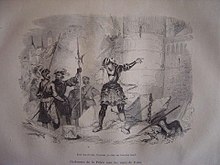Battle of Ruvo
| Battle of Ruvo | |||||||
|---|---|---|---|---|---|---|---|
| Part of the Third Italian War | |||||||
 | |||||||
| |||||||
| Belligerents | |||||||
|
|
| ||||||
| Commanders and leaders | |||||||
|
|
| ||||||
| Strength | |||||||
|
300 lances 300 foot-soldiers[1] |
400 foot-soldiers 600 horsemen 1,300 soldiers[2] | ||||||
| Casualties and losses | |||||||
|
600 dead or captured 1,000 horses captured | Minimal | ||||||
The Battle of Ruvo was fought on 23 February 1503 between a Spanish army under Gonzalo Fernández de Córdoba and Diego de Mendoza, and a French army commanded by Jacques de la Palice. The battle was part of the Second Italian War and was fought at the town of Ruvo in the Province of Bari, modern-day Italy. The result was a Spanish victory.
Background[]
Following the Treaty of Granada signed on 11 November 1500, Spanish monarch Ferdinand the Catholic and Louis XII of France agreed that each power takes a partition of the Kingdom of Naples. The deal soon fell through, however, and Spain and France resumed their war over the kingdom. This resulted in the Second Italian War.
Battle[]
During the end of 1502 and the early part of 1503 the Spanish stood at bay in the entrenched camp at Barletta near the Ofanto river on the shores of the Adriatic sea. Upon hearing about the retreat and departure of Louis d'Armagnac, Duke of Nemours, Gonzalo decided to launch an offensive in a Moorish guerrilla style on the town of Ruvo which was defended by Jacques de la Palice.[1]
Gonzalo de Córdoba stormed the town at early morning launching a cannonade offensive. Soon after, he faced a resolute resistance by the French. However, within four hours he opened a breach from where the Spanish soldiers could enter and launch the assault. Fighting with swords lasted for seven hours and reached houses and streets until Jacques de la Palice was wounded and held prisoner.[3]
The Spanish army soon decided to get back to Barletta while Louis d'Armagnac tried to return to Ruvo to help the French army. Once there he found the Spanish flag already waving in the walls of the city and understood that he arrived behind schedule and stopped to follow ahead.[3]
Footnotes[]
- ^ a b Prescott, William Hickling (2004). History of the Reign of Ferdinand and Isabella (Vol. III) (1841) (in Spanish). Digital Antiquaria. p. 34. ISBN 1-58057-289-8.
- ^ Suárez Fernández, Luis (1990). El Camino Hacia Europa (in Spanish). Ediciones Rialp. pp. 274–275. ISBN 84-321-2589-X.
- ^ a b Historia militar de España - Asalto a Ruvo (Primavera de 1503) Archived January 28, 2007, at the Wayback Machine (in Spanish)
References[]
- Phillips, Charles; Alan Axelrod (2005). Encyclopedia of Wars. New York: Facts on File. ISBN 0-8160-2851-6.
- 1503 in Italy
- Battles of the Italian Wars
- Battles involving Spain
- Battles involving France
- Conflicts in 1503
- Ruvo di Puglia
- French battle stubs
- Spanish battle stubs
